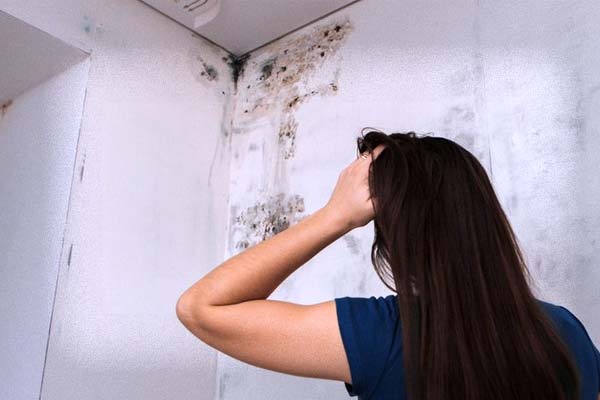Have you ever left your clothes in the washer for an extended period, only to discover them later emitting an unpleasant odor? The musty, mildewed scent is far from welcoming, and eliminating it can be quite challenging. Yet, if you notice this smell in different parts of your home, it could indicate a more serious problem – mold development.
Mold has a distinct musty smell but has also been described as weather earthy small or similar to the smell of wet socks. The smell itself doesn’t actually come from the mold itself, but rather the gases emitted by the mold as it grows.
The smells and odors given off my mold growths are highly unpleasant and can be difficult to get rid of, even after the mold has been remediated.
Can the smell of mold make you sick?

While the impact of MVOCs on people in domestic settings is less well understood, there have been documented cases of ill effects and adverse symptoms in persons who have been exposed to these gases in occupational indoor settings.
Usually, this exposure occurs at high levels over long periods of time, such as workers on a building site that might have a mold problem. Mold allergy sufferers may be more susceptible to MVOCs, but further investigation in this arena is needed, according to the United States Environmental Protection Agency.
Some of the symptoms that can be caused by exposure to MVOCs includes:
- Nausea
- Headaches
- Lightheadedness or dizziness
- Fatigue
- Runny nose and nasal
- irritation
What does mildew smell like?
Mildew is simply another type of mold. Although the two terms are often used interchangeably, mildew is most conventionally understood as a type of mold growth that usually grows flat (not with a fluffy, cottony, or velvety texture). The mold you find in your bathroom is one of the more common types of mildew.
Mildew typically grows in spaces where moisture levels are high. Bathrooms, laundries, and basements provide a great environment for mildew growths to take root.
Very often, mildew will be accompanied by that same damp, musty smell that other molds carry. If the mildew in your home is growing quickly, it may give off more MVOCs, and have a much stronger smell.
What should I do if I smell mold?
Sometimes you will pick up an odor similar to that given off by mold and mildew, but may not be able to spot any growing in your home.
In these situations, it can be helpful to have the air quality in your home tested by a certified air quality inspection specialist. They will be able to perform a test known as a mold spore count test. This test measures the number of mold spores per square meter of air.
If the results of this test indicate an unusually high number of mold spores in the air inside your home, it could be a sign that you have some hidden mold growing somewhere in your home. In this situation, you may need further investigation to identify and remedy any potential mold growths.
Use this free service to test your air quality
HomeGardenGuides.com is a free service that quickly matches you with top voted local air quality and mold inspection specialists. These specialists, including air quality inspection specialists, can help test the quality of the air in your home.
The results of this inspection can help determine whether the odors you are smelling indicate that you have mold or mildew growing in your home.
You can get 3 estimates fast by real, certified experts in your area in just 2 minutes by following the simple steps below.
- Scroll to the top of the page and enter your Zip code.
- Answer questions about your air quality testing job.
- The details of your job will be forwarded to three local experts. They will send you a price estimate for the job and some friendly advice.
IMPORTANT: There is no obligation to hire. This is a free tool and service to be used at your pleasure.

Difference between mold and mildew
Perhaps one of the easiest ways to understand the difference between mold and mildew is their visual appearance and growth profile.
Mildew has a flat growth profile, meaning that it does not grow with a fluffy or cottony texture that can sometimes be seen on other types of mold. Where other molds may resemble mini mushrooms, mildew will grow flat and can often go undetected unless growing in large quantities.
That being said, mildew is just another type of mold (there are over 100,000 species of mold in total!), and shares many of the same characteristics and qualities.
Both mold and mildew are spread through tiny, microscopic spores, and both thrive in damp, moist environments. And, of course, both come with that musty smell from the MVOCs that they give off as they grow and spread!
What are the signs of mold in your house?
Given that it spreads through tiny, microscopic spores, it can often be difficult to tell whether you have a mold outbreak in your home until it has grown significantly in size.
Obviously, mold’s damp musty smell is one of the key indicators of mold growth in the home.
As well as some of the more obvious visual and physical signs that you have mold growth on your hands, you may also begin to suffer from a variety of symptoms related to mold exposure.
If you notice any of the below signs but are unsure whether there is actually mold in your home, it is always better to err on the side of caution. A professional inspection from a qualified, certified mold inspector can help set your mind at ease or provide you with friendly advice on how best to remove the mold.
VIsual indicators and signs of mold growth
For many homeowners, these visual signs of mold growth will be the first indication that there is a mold problem in your home.
As mold growth can not occur without a source of moisture, many of these signs are also related to signs of dampness or a moisture problem in your home.
Visual indicators of mold growth include:
Flat spots or raised textured growths in a variety of colors that will typically lighten once a drop of bleach is placed on it (can range from white, grey, green, brown, black, blue, and even orange!)
- Warped wood around skirting boards, door frames, or window sills (an indication of moisture problem)
- Cracked, peeling, or chipped paint (a sign that there could be dampness spreading underneath the paint)
- Obvious signs of dampness or moisture (can be the result of a leak, flood, or even a loose roof tile)
Allergy symptoms and signs of a mold growth
For those unfortunate enough to be allergic or sensitive to mold, you will often suffer a host of nasty symptoms that can indicate that there might be a mold growth lurking in your home.
Asthmatics also tend to suffer from excessive exposure to mold.
Allergy symptoms that can occur as a result of mold growth in your home include:
- Respiratory issues
- Red and irritated eyes
- Headache
- Rash
- Runny nose
- Wheezing
- Coughing
- Asthma attacks (in asthmatics, usually in extreme cases)

Will a dehumidifier get rid of a musty mold smell?
While a dehumidifier may help you in controlling moisture in your home, thereby controlling any potential outbreaks of mold in your home, it can not actually remove a musty mold smell.
This is because the only surefire way of removing the smell of mold from your home is to remove the mold itself. As the smell of mold is caused by gases that the mold gives off as it grows, any other solution (whether it be a dehumidifier, room spray, or scented candle), will only temporarily mask the problem.
How to get rid of moldy smell/ odor?
Anyone who has suffered from the unpleasant smell of mold in their home will tell you that you want to get rid of it as soon as possible! It’s not just the need to remove an unpleasant odor from your home that is important in this situation either – the smell of mold means that there is mold, and this can prove potentially hazardous to your health!
The only guaranteed way to remove the distinctive moldy smell from your home or property is by actually removing the mold itself.
How to get rid of mold
If the mold growth in your home measures less than 3 feet by 3 feet, then you may be able to remove it yourself. This is a fairly straightforward process and can be done with a few common household products you probably already have lying around.
Once you have addressed and remedied the underlying moisture issue that has caused the mold growth in the first place, you can tackle the mold itself. Make up a solution of bleach and water, adding a dash of dishwashing liquid if you’re treating a porous material such as drywall, and apply it to the affected area.
Allow the solution to dry, and retreat if required. Some more stubborn mold growths may require some scrubbing!
Always ensure you are wearing the proper protective equipment when attempting to remediate mold yourself. You will need a mask, gloves, protective eyewear, and sturdy enclosed shoes at the very minimum.








